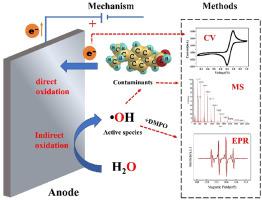当前位置:
X-MOL 学术
›
Chemosphere
›
论文详情
Our official English website, www.x-mol.net, welcomes your
feedback! (Note: you will need to create a separate account there.)
电化学高级氧化过程中阳极氧化处理废水:机理、直接和间接氧化检测方法的进步
Chemosphere ( IF 8.1 ) Pub Date : 2022-10-26 , DOI: 10.1016/j.chemosphere.2022.136993
Rui Fu 1 , Peng-Shuang Zhang 1 , Yuan-Xing Jiang 1 , Lin Sun 2 , Xu-Hui Sun 1
Affiliation

|
电化学高级氧化法 (EAOP) 因其氧化能力强、降解效率高、操作简单、反应温和等优点,已应用于废水中难降解污染物的降解。在电化学过程中,阳极氧化 (AO) 应用最广泛,其机理主要分为直接氧化和间接氧化。直接氧化是指污染物在阳极通过直接电子转移被氧化。间接氧化是指在电解反应过程中产生活性物质,作用于污染物。AO 工艺的机理受许多因素控制,包括电极类型、电催化剂材料、废水成分、pH 值、施加电流和电压水平。探究电化学处理的反应机理非常重要,电化学处理决定了反应的效率、反应的产物和反应的程度。本文首先综述了目前AO过程机制的研究进展,并详细总结了常见AO过程中影响因素引起的不同机制。然后,综述了区分直接氧化和间接氧化机制的策略和方法,如中间产物分析、电化学测试分析、活性物质检测、理论计算,并分析了这些方法的局限性。最后,对电化学高级氧化机理的研究提出了一些建议。

"点击查看英文标题和摘要"


































 京公网安备 11010802027423号
京公网安备 11010802027423号